SPECIAL EDITION
Water and Environment
Evaluation of the Germination of Corn Seeds Treated and Irrigated with Magnetized Water
Matheus Barcelos de Sousa*1, João José da Silva Júnior2, Sérgio Augusto Ribeiro3, Marcelo Giovane Alves4
*1Corresponding author. University of Brasília (FAV/UnB), Faculty of Agronomy and Veterinary Medicine, Brasília – DF, Brazil. E-mail: mbarcelosunb@gmail.com
Keywords: Magnetic induction, irrigation, seed germination, seed treatment, corn, structured water.
• Received: October 30, 2021
• Revised: December 19, 2021
• Accepted: February 21, 2022
• Published: April 25, 2022
Abstract
Corn is one of the most economically important crops in Brazil, and sowing it requires special attention to soil water availability. Magnetized water irrigation is an alternative to irrigation and seed treatment. Thus, the objective of this work was to evaluate the germination of corn seeds treated and irrigated with magnetized water. The experiment was carried out in May 2021 in a greenhouse at Fazenda Água Limpa, belonging to the University of Brasília (UnB). Corn seeds were subjected to four irrigation treatments with magnetized water, namely: magnetic induction of 0.28 T (T1), 0.229 T (T2), 0.029 T (T3) and 0 T (control). The variables evaluated were germination percentage, mean germination time, fresh seedling mass, dry seedling mass and seedling vigor. The design used was completely randomized, with five replications. Water magnetization was performed using three magnetizers, Jiangsu YLD Water Processing Equipment Co. Ltd. (T1), Structured Water Agriculture Magnetizer (T2) and Magnetizer Industrial Technologies Inc. (T3). The studied levels of magnetic induction in the irrigation water, as variables germination percentage and seedling vigor, differentiated among themselves at the level of 5%. Mean germination time, seedling fresh mass and seedling dry mass did not differ between treatments.
Introduction
Corn is one of the main crops grown in Brazil and according to the Agricultural Cooperative of the Federal District Region (Web ref. 1), in the region of the Directed Settlement Program – PAD/DF, 47,600 hectares harbor corn crops. In addition to the commercial interest of large producers, the culture of corn has significant sociocultural importance for small and medium producers, due to its wide application in fresh human and animal consumption.
Corn is one of the most interesting, cultivated plants in terms of its origin, structure and variation. It is only known in cultivation and, in its current form, shows no indication that it could survive without man’s care. Research has developed such different types of maize that its cultivation is possible from the Equator to the limits of temperate lands, and from sea level to altitudes above 3,600 m. This adaptability, represented by varied genotypes, is parallel to the variety of its use as food, forage or in industry (Magalhães et al. 1995).
Crop production is predominantly divided into two annual crops, the first sown by the end of December (main crop) and the second from early January (safrinha). Thus, planning of sowing for optimizing the supply of water resources is important. In Brazil’s Federal District, the rainy season occurs between the months of October and April, so the cultivation of corn outside this period can reduce seed germination, the duration of the vegetative stages of the plants, and productivity.
Corn is a quick germination plant. Under ideal conditions of light, temperature, and humidity of the environment in which the seed was sown, germination occurs four to five days after sowing, and corn is an excellent plant to make and demonstrate how to carry out a germination test (Macedo, 2014).
The basis for high productivity of any culture is related to the establishment of plants in the field, which in turn depends on the rational management and quality of the seeds used (Machado et al. 2001).
The plant absorbs water from the soil to meet its physiological needs and, in this way, supply the need for nutrients transported along with the water, in the form of mass flow (Magalhães et al. 2006).
The process that begins with the resumption of growth by the seed embryo, developing to the point where it forms a new plant with full conditions to nourish itself, becoming independent, is called germination (Kramer and Kozlowski, 1972). Germination occurs in a sequence of physiological events influenced by factors external (environmental: light, temperature, availability of water and oxygen) and internal (inhibitors and promoters of germination) to the seeds, which can act by themselves or in interaction with others (Kramer and Kozlowski, 1972; Nassif et al. 1998).
In germination, after imbibition of the seed, it absorbs water and swells, the hydrated integument softens and breaks down, the growth tissues develop with the food supply by the cotyledons, the radicle emerges and fixes, the leaves begin to form, increasing the photosynthetic potential of the seedling, the absorption of nutrients from the environment begins, the cotyledons undergo abscission and the plant does not depend on the nutrients of the seed (Floriano et al. 2004).
Thus, the use of magnetized water during different food production processes, including the germination of seeds, is a promising technique but still lacking information for the best use.
Researchers consider that the prospect of using cheap magnetic energy to improve soil properties and plant growth and development may be of great practical importance (Mohamed et al. 2013). Magnetic and electromagnetic treatments are being used in agriculture, as a non-invasive technique, to improve seed germination and increase crop productivity (Martínez et al. 2009).
Several studies point to evidence that water exposed to the magnetic field has different properties from non-magnetically treated water. The main changes observed in magnetized water were the adsorption of water on surfaces (Ozeki et al. 1996), crystallization and precipitation of salts (Katsuki et al. 1996; Kronenberg, 1985), solubility of some minerals (Hasson et al. 1985; Herzog et al. 1989; Bogatin et al. 1999; Gehr et al. 1995) and surface tension (Joshi and Kamat, 1966).
Therefore, the objective of this work was to evaluate the germination of treated corn seeds irrigated with magnetically treated water.
Materials and Methods
Experiment Site
The experiment was carried out in May 2021 inside a greenhouse at the Água Limpa Farm, belonging to the University of Brasília (UnB) and located across the geographic coordinates of latitude 15°56’50” S and longitude 47°56’02” W. The altitude of the site is 1,080 m above sea level and the climate of the region is type Aw, according to the Köppen-Geiger climate classification (Peel et al. 2007), tropical with a dry season, with an average temperature of 23.2 °C and average rainfall of 1,660 mm year-1, concentrated between the months of October and April.
Variety Used
The variety of corn used was Cativerde 02, produced by the Sustainable Rural Development Coordination of the State of São Paulo – CATI, marketed by BRSEEDS. The seeds have, according to the trader, a minimum purity of 98% and a minimum germination of 85%.
Treatments
The design used was completely randomized, with four treatments and five replications each. The different levels of magnetic induction adopted were: T1 – 0.28 Tesla (T); T2 – 0.229 T; T3 – 0.029 T; T4 – 0 T (control).
The magnetization of water occurs through the passage of its flow through a magnetic field, which is formed by magnets. The magnetic field varies according to the size and shape of the magnets, but once the magnets are installed, the magnetization intensity remains unchanged. To carry out the water magnetization, three different magnetizers were used, installed at the beginning of each main line, namely, Jiangsu YLD Water Processing Equipment Co., Ltd. (T1), Structured Water Agricultural Magnetizer (T2) and Magnetizer Industrial Technologies Inc. (T3).
The Jiangsu YLD Water Processing Equipment Co. is cylindrical in shape, with dimensions of 0.16 by 0.45 meters and a weight of 5 kilograms. Water flows through 4 channels between the magnets, with a water inlet diameter of 2 inches.
The Structured Water Agricultural Magnetizer has a magnetic induction intensity of 2,290 Gauss or 0.229 Tesla, evenly distributed across a 2-inch diameter and over a length of 0.098 m. In addition, 95% of the magnetic intensity is concentrated in its interior, meeting the international safety limits established by the World Health Organization and the International Commission on non-ionizing radiation protection (ICNIRP). Permanent magnets with a remaining magnetic induction intensity of 12,000 Gauss or 1.2 Tesla are used, and can be used at temperatures up to 80 °C. This product was developed to favor use in irrigation systems for food production in agriculture. It has a magnetization capacity of up to 11,000 liters of water per day at a speed of 2 m/s.
Magnetizer Industrial Technologies Inc. has a rectangular shape, with the magnets having dimensions of 0.1 by 0.065 meters. The magnetizer has two plates with two magnets in parallel and is installed directly to the irrigation piping.
The seeds were subjected to treatments through immersion for a period of 3 hours and 30 minutes, in a volume of 0.25 liters, according to the respective treatment, using fifty seeds per treatment. Subsequently, they were seeded in polystyrene trays, with 200 cells, filled with Bioplant brand substrate, and from then on, they were irrigated with the respective treatments at a frequency of four times a day for five minutes each. The first irrigation was at 8:00 am and the subsequent ones were every three hours. Irrigation was performed by nebulizer-type sprinklers, with three nebulizers per tray, with a flow rate of 9.3 liters per hour each.
Parameters Evaluated
For the germination evaluation, the following parameters were considered: (Hozayn et al. 2018)
Germination Percentage (%):
The total number of germinated seeds was counted daily, and the percentage was calculated on day 14 after planting according to the following equation:
![]()
Mean Germination Time (MET):
It was calculated based on the equation of Ellis and Roberts (1981):

Where n is the number of seeds that germinated (emerged) on days D and D is the number of days counted from the beginning of germination.
Fresh Seedling Mass:
Twenty-five normal seedlings were measured 14 days after planting to determine fresh mass (gram) using a scale.
Seedling Dry Mass:
The seedlings that were used for fresh mass were dried in a hot air oven at 70 ºC for 48 hours to obtain the seedling dry mass (gram) under laboratory conditions (Krishnasamy et al. 1990).
Seedling Vigor:
It was calculated following Abdul Baki and Anderson (1973) as:
Statistical Analysis
The data were subjected to analysis of variance by the F test at 5% significance and the means between treatments were compared by the regression test, using the software for statistical analysis Sisvar version 5.6 – DEX/UFLA.
Results and Discussion
The raw data collected throughout the experiment for the treatment at the magnetization level of 0.28 Tesla are distributed in Table 1.
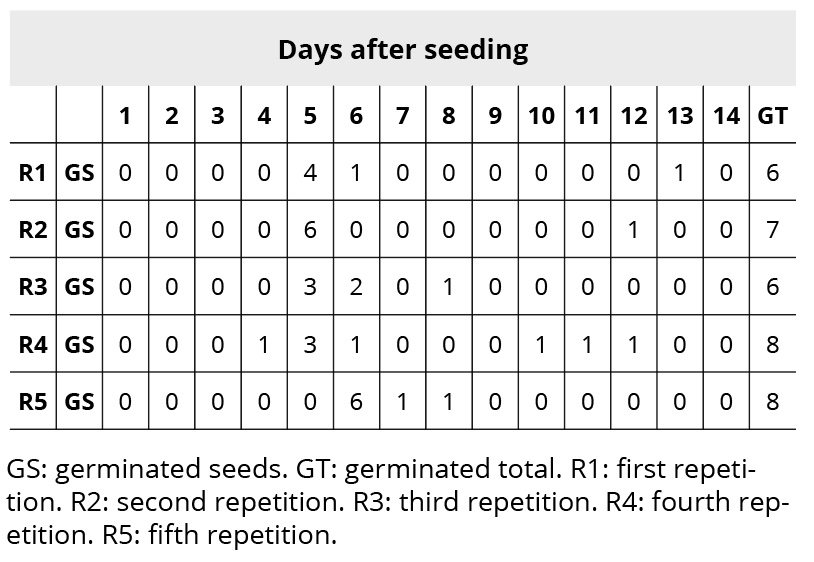
Table 1. Germination raw data for the 0.28 Tesla magnetic level.
The raw data collected throughout the experiment for the treatment at the magnetization level of 0.229 Tesla are distributed in Table 2.
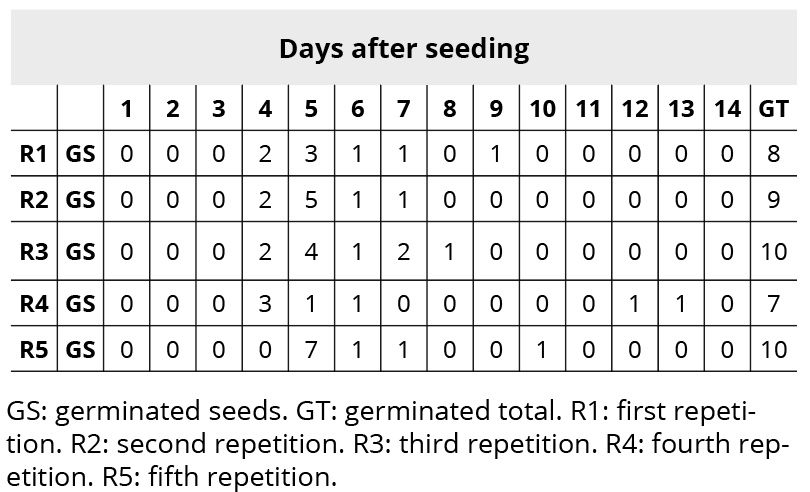
Table 2. Germination raw data for the 0.229 Tesla magnetic level.
The raw data collected throughout the experiment for the treatment at the magnetization level of 0.029 Tesla are distributed in Table 3.
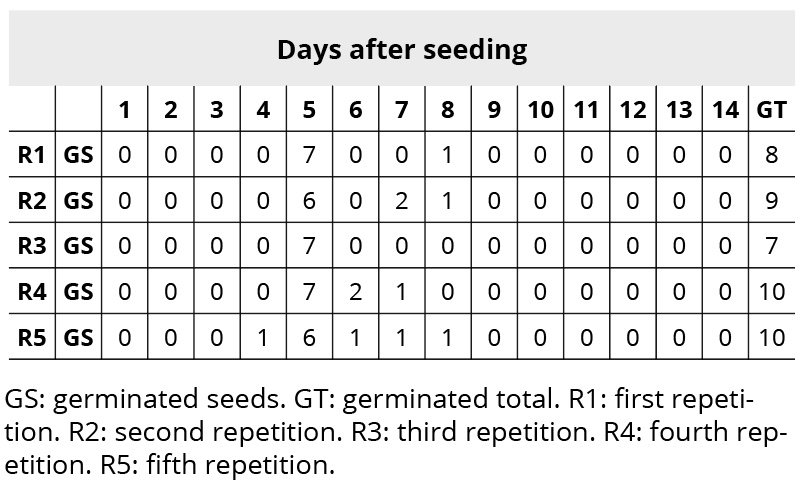
Table 3. Germination raw data for the 0.029 Tesla magnetic level.
The raw data collected throughout the experiment for the control treatment are distributed in Table 4.
The different levels of magnetization used in seed treatment and irrigation significantly influenced (p < 0.05) the variable percentage of germination (%) (Table 5). Seed germination occurred in all treatments, with treatments T2 and T3, 0.229 and 0.029 T, respectively, those with the highest average, with the value of 88% of germinated seeds (Figure 1). Also, treatments T2 and T3 presented mean value for the percentage of germination 29.41% greater than the control. Also, treatments T2 and T3 presented average value for the percentage of germination 29.41% greater than the control.
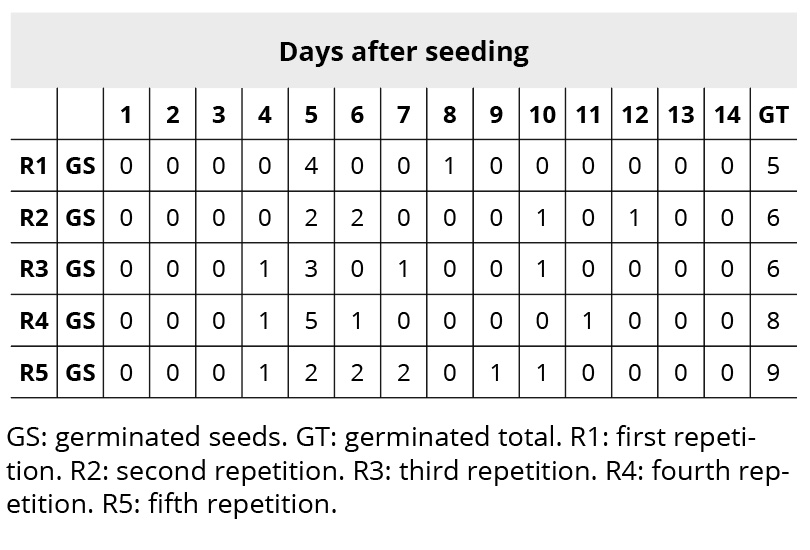
Table 4. Germination raw data for the control treatment.
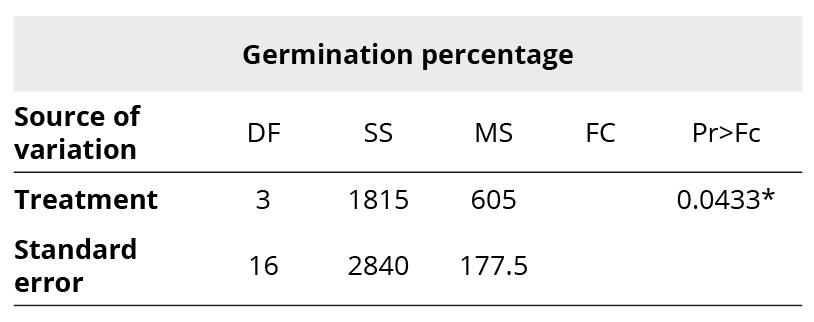
Table 5. Analysis of variance for the percentage of germination variable.

Figure 1. Mean values for percentage of corn seed germination as a function of magnetic induction levels applied in irrigation water of 0; 0.029; 0.229 and 0.28 T.
The regression equation (Figure 2) that most adequately represented the germination percentage response to the different levels of magnetic induction applied to the irrigation water was the quadratic model with the correlation coefficient R² = 0.9114.

Figure 2. Percentage of maize seed germination as a function of magnetic induction levels applied in irrigation water of 0; 0.029; 0.229 and 0.28 T.
With a growing demand for healthier foods, research, and development of technologies capable of increasing productivity without affecting the environment, is essential. In this scenario, research on the magnetization of water used for irrigation has been carried out to develop a technique with low environmental impact and which can positively increase the productive and nutritional aspects of plants. Furthermore, it is an easy-to-apply technique, and its use can be an alternative to accelerate the germination process of seeds with greater dormancy.
Flores (2019) studied the effects of running water by magnetism and far infrared on sorghum germination and water relations. The author observed a higher percentage of sorghum (Sorghum bicolor) seed germination for mineral and reverse osmosis waters submitted to magnetism and far infrared, in relation to the control, without treatment with magnetism and far infrared. Aguilera and Martin (2016), working with seedling germination of Solanum lycopersicum L. under irrigation with magnetically treated water, at the level of 0.12 Tesla, and untreated water, obtained a higher germination percentage for magnetized water. Vieira et al. (2020), working with the production of vegetable seedlings under seed magnetization and the use of magnetized water, found higher values for percentage of germination for the treatment in which the seedlings were irrigated with water treated with an Irrifes magnetizer (0.15 T).
There was no significant effect of the levels of magnetic induction applied in the irrigation water on the mean values of mean germination time (Table 6). Although there was no significant difference between treatments, the one with the lowest mean germination time was T3 (0.029 T), with a mean value of 5.41 days (Figure 3).
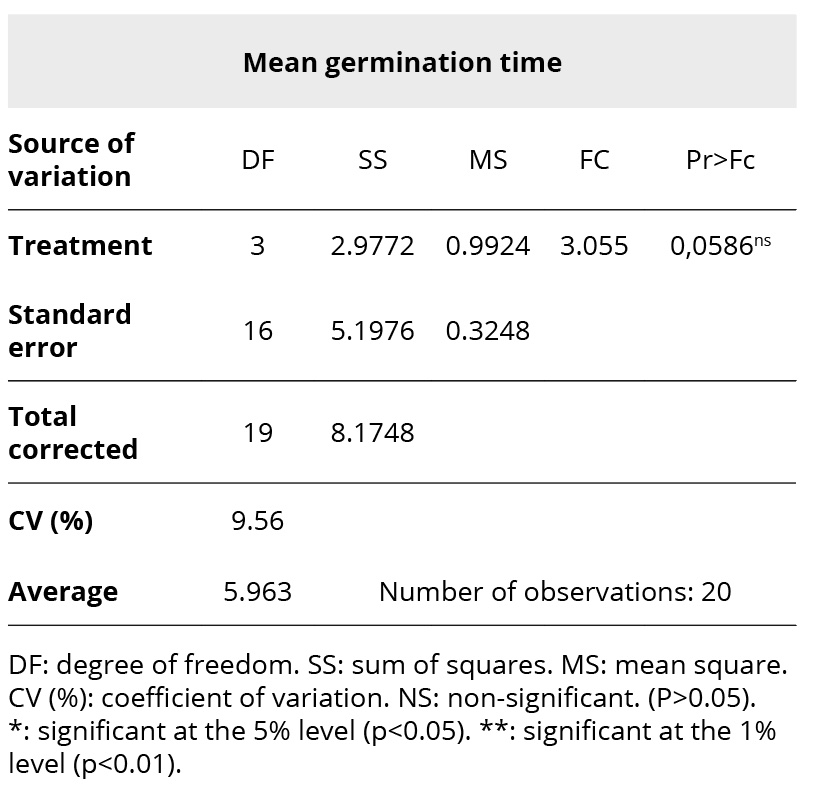
Table 6. Analysis of variance for the mean germination time variable.
Despite the fact that the different levels of magnetic induction do not significantly represent the variation in the mean germination time of maize seeds, this parameter can still be represented by a quadratic regression, at a significance level of 5%, with a coefficient of correlation R² = 0.8075.

Figure 3. Mean values for mean germination time of corn seeds as a function of magnetic induction levels applied in irrigation water of 0; 0.029; 0.229 and 0.28 T.
Mahmood and Usman (2014), cited by Flores (2019), evaluated the effect of magnetic treatment (235 mT; flow 3L/min) in four types of water for irrigation (sewage, saline solution, irrigation channel and tap) in the germination of seeds, germination rate and speed, germination index and root growth of maize (Zea mays), submerging them in water for 24 hours, and verified that treatments with water treated by magnetism promoted the germination of maize seeds, reducing germination time in 17.9%. Vieira et al. (2020), working with the production of vegetable seedlings under seed magnetization and the use of magnetized water, found higher values for mean germination time for the treatment in which seeds were treated with an Irrifes magnetizer (0.15 T).
There was no significant effect of the levels of magnetic induction applied in the irrigation water on the mean values of seedling fresh mass (Table 7).
Although there was no significant difference between treatments, the one with the highest value for seedling fresh mass was T1 (0.28 T), with an average value of 2.44 grams (Figure 4).
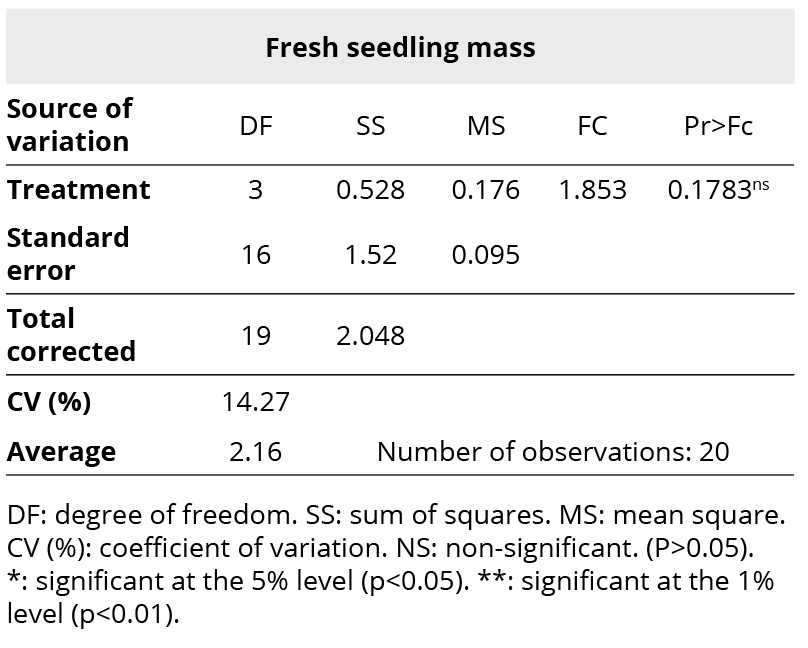
Table 7. Analysis of variance for seedling fresh mass variable
Mahmood and Usman (2014), working with magnetization in different types of water, observed an increase in the fresh mass of seedlings, after 15 days of planting, of 24.8%, 21.3%, 20.1% and 17.4%, respectively, compared to the control treatment.
There was no significant effect of the levels of magnetic induction applied in the irrigation water on the mean values of seedling dry mass (Table 8). Although there was no significant difference between treatments, the one that obtained the highest value for seedling dry mass was T2 (0.229 T), with an average value of 0.276 grams (Figure 5).

Figure 4. Mean values for fresh mass of maize seedlings as a function of magnetic induction levels applied in irrigation water of 0; 0.029; 0.229 and 0.28 T.
Vieira et al. (2020), working with the production of vegetable seedlings under seed magnetization and the use of magnetized water, found higher values for shoot dry mass for the treatment in which seedlings were irrigated with water treated with an Irrifes magnetizer (0.15 T). Pradela et al. (2018), working with a Sylocimol Rural magnetizer, found a significant difference for shoot dry mass for the lettuce crop, the result being superior for the treatment using magnetization.
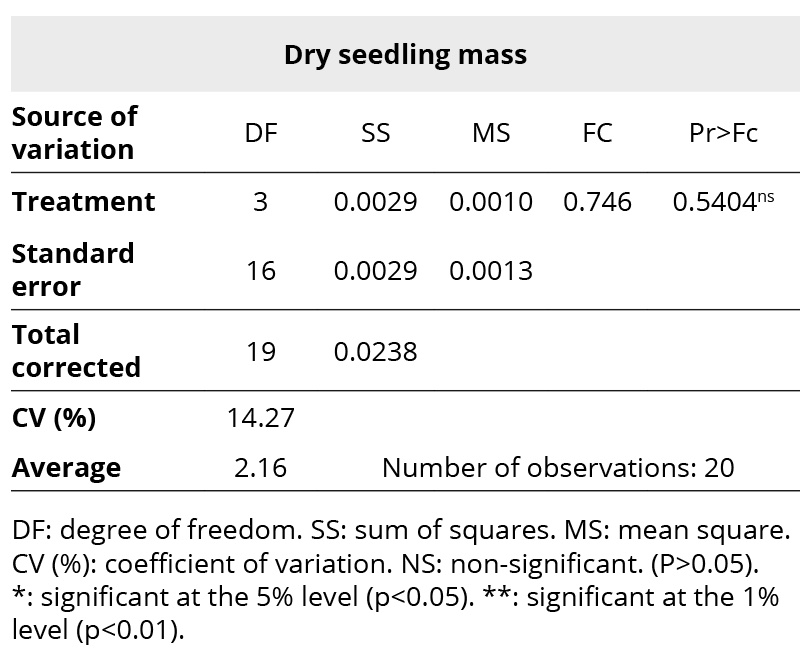
Table 8. Analysis of variance for the seedling dry mass variable.

Figure 5. Mean values for dry mass of maize seedling as a function of magnetic induction levels applied to irrigation water of 0; 0.029; 0.229 and 0.28 T.
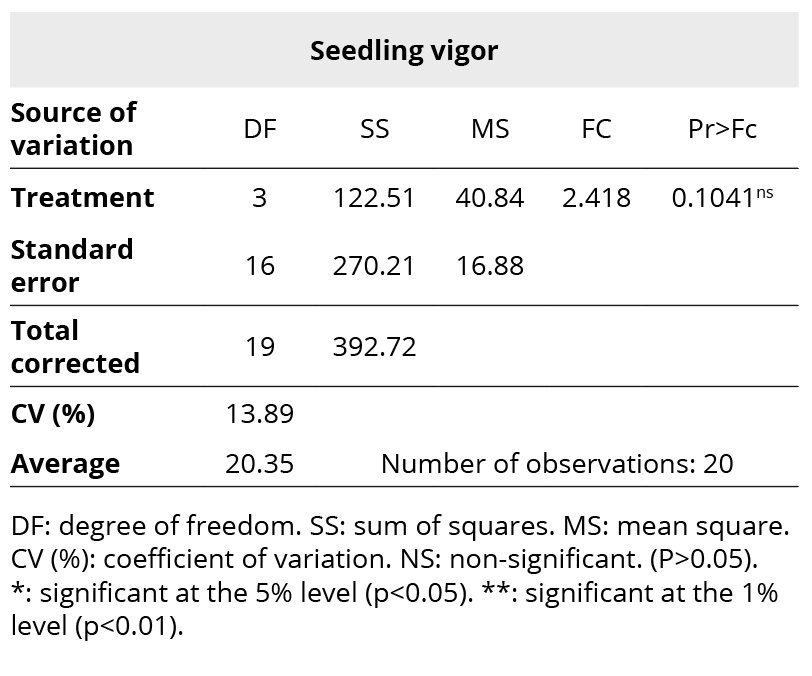
Table 9. Analysis of variance for the seedling vigor variable.

Figure 6. Mean values for corn seedling vigor as a function of magnetic induction levels applied in irrigation water of 0; 0.029; 0.229 and 0.28 T.
The different magnetization levels used in seed treatment and irrigation did not affect the seed vigor variable at the 5% level (Table 9). The treatment that obtained the highest mean for the seedling vigor parameter was T2 (0.229 T), with an average value of 23.99 (Figure 6).
The regression equation (Figure 7) that most adequately represented the germination percentage response to the different levels of magnetic induction applied to the irrigation water was the quadratic model with the correlation coefficient R² = 0.9992.

Figure 7. Seedling vigor of corn seeds as a function of magnetic induction levels applied in irrigation water of 0; 0.029; 0.229 and 0.28 T.
Conclusion
The different levels of magnetic induction applied via seed treatment and irrigation water, in corn seeds, significantly influenced (p<0.05) the variable percentage of germination. There was no significant effect of the different levels of magnetic induction applied in the irrigation water on the variables mean germination time, fresh seedling mass, dry seedling mass and seedling vigor. Since it is a technology with recent application to agriculture, further research is needed to assess the impact of using other levels of magnetization.
Discussion with Reviewers (DWR)
Reviewer: The variety of corn used, Cativerde 02, according to the trader BRSEEDS, has a minimum purity of 98% and a minimum emergence of 85%. How can these characteristics influence the percentage of emergence found in the study?
Authors: Because the corn seed used is a variety and not a transgenic one, the variability presented in the data occurred. Variety corn results from a natural cross between seeds of the same lineage, different from a hybrid seed, which is obtained by two other varieties. With the use of transgenic seeds, the germination in the control would be quite homogeneous, due to the characteristic of the seed.
Reviewer: How could the presented research contribute to the studies about the molecular structure of water and its connection with water management?
Authors: The magnetic water treatment modifies the water clusters, thus altering their structure. This change, according to research cited in the article, alters, among some parameters, the absorption of water by plants. Thus, more research could be done in order to discover the different impacts of magnetically treated water on agricultural production. Among these possibilities, this research stands out, which demonstrates that by treating and irrigating maize seeds, it is possible to increase the germination percentage and, thus, ensure homogeneous production.
References
Abdul-Baki AA, Anderson JD (1973). Vigour determination in soybean by multiple criteria. Crop Sci 10: 31-34.
Aguilera JG, Martín RM (2016). Água tratada magneticamente estimula a germinação e desenvolvimento de mudas de Solanum lycopersicum L. Revista Brasileira de Agropecuária Sustentável 6: 47-53.
Bogatin J, Bondarenko NP, Gak EZ, Rokhinson EF, Ananyev IP (1999). Magnetic treatment of irrigation water experimental results and application conditions. Environmental Science and Technology 33: 1280-1285.
Ellis RA, Roberts EH (1981). The quantification of ageing and survival in orthodox seeds. Seed Sci. Technol 9: 373-409.
Flores LAE (2019). Efeito da água corrigida por magnetismo e infravermelho na emergência e relações hídricas. Universidade Estadual de Maringáz: 1-42.
Floriano EP (2004). Emergência e dormência de sementes florestais. Caderno Didático nº 2 1: 1-19.
Gehr RZA, Zhai J, A. Finch SRR (1995). Reduction of soluble mineral concentrations in CaSO4 saturated water using a magnetic field. Water Research 29: 933- 940.
Hasson D, Bramson D (1985). Effectiveness of magnetic water treatment in suppressing CaCO3 scale deposition. Ind. Eng. Chem. Process Des. Dev 24: 588-592.
Herzog RE, Shi Q, Patil JN, Katz JL (1989). Magnetic water treatment. The effect of iron on calcium carbonate nucleation and growth. Langmuir 5: 861-867.
Hozayn M, AAE, Zalama MT (2018). Magneto-priming for improving germination, seedling attributes and field performance of barley (Hordeum vulgare L.) under salinity stress. Middle East J. Agric Res 7: 1006-1022.
Joshi KM, Kamat PV (1966). Effect of Magnetic Field on the Physical Properties of Water. Indian Chemical Society 43: 620-622.
Katsuki A, Tokunaga R, Watanabe SI, Tanimoto Y (1996). The effect of high magnetic field on the crystal growth of benzophenone. Chemistry Letters 8: 607- 608.
Kramer PJ, Kozlowski T (1972). Fisiologia das árvores. Fundação Calouste Gulbenkian: 745.
Krishnasamy V, Seshu DV (1990). Phosphine fumigation influence on rice seed germination and vigor. Crop Sci 30: 28-85.
Kronenberg KJ (1985). Experimental Evidence for Effects of Magnetic Fields on Moving Water and Fuels. IEEE Trans. Magnetics 21: 2059-2061.
Macedo DXS, Santos VC, Vieira JM, Carvalho JAD, Albiero D, Macedo Júnior JS (2014). Teste de emergência. Revista Cultivar, Grandes culturas 177: 14-15.
Machado JC, Oliveira JA, Vieira MGGC, Alves MC (2001). Uso da restrição hídrica na inoculação de fungos em sementes de milho. Revista Brasileira de Sementes 23: 88-94.
Magalhães PC, Durães FOM, Paiva E (1995). Fisiologia da planta de milho. Circular técnica, EMBRAPA 20.
Magalhães PC, Durães FOM, Paiva E (2006). Fisiologia da produção de milho. Circular técnica, EMBRAPA 76.
Mahmood S, Usman M (2014). Consequences of Magnetized Water Application on Maize Seed Emergence in Sand Culture. Journal of Agricultural Science and Technology 16: 47-55.
Martínez E, Carbonell MV, Flórez M, Amaya JM, Maqueda R (2009). Germination of tomato seeds (Lycopersicon esculentum L.) under magnetic field. International Agrophysics 23: 45–49.
Mohamed AI, Ebead BM (2013). Effect of irrigation with magnetically treated water on faba bean growth and composition. International Journal of Agricultural Policy and Research 1: 24–40.
Nassif SML, Vieira IG, Fernades GD (1998). Fatores Externos (ambientais) que Influenciam na Emergência de Sementes. Informativo Sementes IPEF.
Ozeki S, Miyamoto J, Ono S, Wakai C, Watanabe T (1996). Water−Solid Interactions Under Steady Magnetic Fields. Magnetic-Field-Induced Adsorption and Desorption of Water. Journal of Physical Chemistry 100: 4205.
Peel MC, Finlayson BL, McMahon TA (2007). Updated world map of the Köppen-Geiger climate classification. Hydrol. Earth Syst. Sci 11: 1633-1644.
Pradela VA, Yoshida CHP, Santos DC, Santos RC, Lapaz AM (2018). Produção de mudas de alface em reposta ao uso de água tratada magneticamente. Brazilian Journal of Biosystems Engineering 12: 299-306.
Simoni F, Costa RS, Fogaça CA, Gerolineto E (2011). Sementes de Sorghum bicolor L. – Gramineae, submetidas ao estresse hídrico simulado com PEG (6000). Revista de Biologia e Ciência da Terra 11: 188-192.
Vieira GHS, Grazzioti RM, Lo Monaco PAV, Garcia ADB, Pereira DCS, Meireles RC (2020). Produção de mudas de hortaliças sob magnetização de sementes e uso de água magnetizada. Proceedings of XLIX Congresso Brasileiro de Engenharia Agrícola.
Web References
1. COOPA-DF – Cooperativa Agropecuária da Região do Distrito Federal. Available at: https://coopadf.com.br/o-pad-df [05-11-2021]
